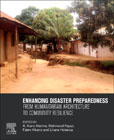
Enhancing Disaster Preparedness: from Humanitarian Architecture to Community Resilience
Martins, Nuno
Fayazi, Mahmood
Hobeica, Liliane
Kikano, Faten
Enhancing Disaster Preparedness: From Humanitarian Architecture to Community Resilience presents valuable information from the UNISDR Sendai Framework for Disaster Risk Reduction, 2015-2030. The framework includes a discussion of risk and resilience from both a theoretical and governance perspective in light of ideas that are shaping our common future. In addition, it presents innovative tools and best practices in reducing risk and building resilience. Combining the applications of social, financial, technological, design, engineering and nature-based approaches, the volume addresses rising global priorities and focuses on our global understanding of the Build Back Better? principle, response to forced displacement, and resilience in decision-making. Other sections present historic and contemporary issues, asking researchers and governments how they can use technological advances, risk and resilience metrics and modeling, business continuity practices, and past experiences to assess disasters and response preparedness and ensure effective response and recovery related to disasters. By presenting a balanced, future perspective of this Build Back Better? principle, as well as methods for preparing for, acting on, and learning from forced displacement situations, the book offers practical ways for communities to prepare for, and respond to, disasters. Follows the global frameworks for disaster risk reduction and sustainability, specifically the UNISDR Sendai Framework for DRR, 2015-2030Offers a balanced perspective of the Build Back Better? principle and future considerationsProvides considerations for preparing, acting and learning from forced displacement situationsExamines the role of humanitarian architecture in building resilience INDICE: Introduction PART I - Humanitarian architecture 1. A humanitarian shelter terminology framework 2. Emergency-housing response to the 2017 hurricanes in Puerto Rico 3. The story of the disaster-relief houses in Iceland 4. The influence of technical assistance in the adoption of safer construction practices in Nepal 5. Refugee participatory design for shelters: An experiment in Syrian camps in Jordan 6. Lessons for humanitarian architecture from design contests focusing on risk and resilience PART II - Building resilience to enhance community preparedness 7. Architects' multifaceted roles in enhancing resilience after disasters 8. Probing for resilience: Exploring design with empathy in Zanzibar, Tanzania 9. Consolidation design as an adaptation strategy in the Toi Market in Nairobi, Kenya 10. Risk and urban design in Brazilian favelas: Linking participation, collective spaces and territorial management PART III - Community resilience and global dynamics 11. Informality versus short-term regularization of the Syrian refugees' situation in Lebanon 12. Resilience and incrementalism: The case of Villa Verde, Chile 13. Climate Action Zones: A clustering methodology for resilient spatial planning 14. The links between vulnerability, poverty, and natural hazards: A focus on the impacts of globalization trends
- ISBN: 978-0-12-819078-4
- Editorial: Elsevier
- Encuadernacion: Rústica
- Páginas: 400
- Fecha Publicación: 01/06/2020
- Nº Volúmenes: 1
- Idioma: Inglés
